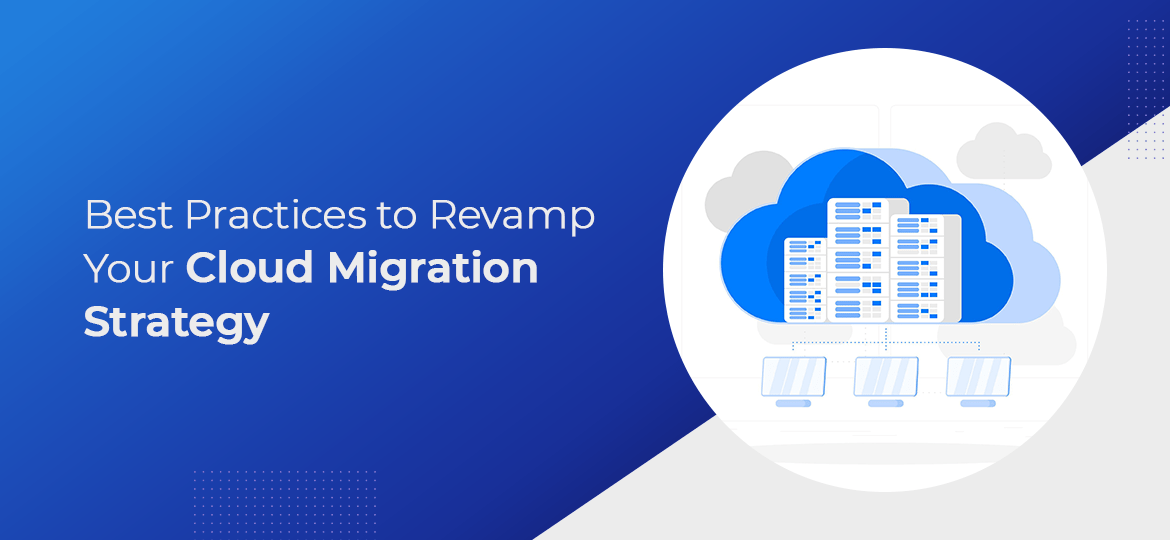
Best Practices to Revamp Your Cloud Migration Strategy
As organizations strive for agility, scalability, and cost-efficiency, the move to the cloud has emerged as a strategic imperative. Cloud migration involves the process of transferring applications, data, and infrastructure from on-premises systems to cloud-based platforms.
TABLE OF CONTENTS
Key to a Strong Migration Strategy
10 Best Practices for a Data-Driven Cloud Migration Strategy
Unleash the Potential of a Transformed Cloud Migration Strategy
Cloud migration empowers organizations to focus on their core competencies and for that need to carefully plan and execute strategy to ensure a seamless transition while mitigating risks. This is where revamping your cloud migration strategy with best practices becomes essential.
In this blog, we will explore the best practices that can help organizations optimize their cloud migration strategy. By following these guidelines, your business can minimize disruptions, maximize efficiency, and fully harness the transformative potential of cloud technology.
So, let’s dive into the key practices that will revamp your cloud migration strategy and set you on the path to success.
KEY TO A STRONG MIGRATION STRATEGY
The benefits of cloud technology are evident, with improved scalability, cost-efficiency, and enhanced accessibility. However, a successful cloud migration requires more than just the desire to embrace the cloud; it necessitates a well-defined migration strategy.
Having a well-defined cloud migration strategy is the key to a successful and seamless transition. A robust strategy ensures that the migration process is data-driven, efficient, and aligned with the organization’s objectives.
10 BEST PRACTICES FOR A DATA-DRIVEN CLOUD MIGRATION STRATEGY
When it comes to revamping your cloud migration strategy, adopting a data-driven approach is essential.
By leveraging data and insights, organizations can make informed decisions, mitigate risks, and ensure a seamless transition to the cloud.
Here are some best practices to consider for a data-driven cloud migration strategy:
1. Automation Acceleration
Automate the discovery phase of your migration process to gather accurate and comprehensive data about your existing applications and dependencies as this accelerates the initial assessment and provides a solid foundation for decision-making.
2. Define Clear Goals
Determine what you aim to achieve with the cloud migration, whether it’s cost savings, scalability, enhanced security, or improved performance as these goals will guide your migration strategy and help prioritize actions.
3. Equipping the Team
Invest in training and upskilling your team to ensure they have the necessary knowledge and expertise to understand cloud technologies, security best practices, and cloud management tools as this will enable them to make informed decisions, handle challenges, and efficiently manage the migration process.
4. Evaluate Cloud Service Providers (CSPs)
Thoroughly evaluate different CSPs to find the one that best aligns with your organization’s needs and requirements. Consider factors such as reliability, scalability, security measures, data compliance, and support services provided by the CSP.
5. Choose the Right Arsenal
Select the appropriate tools and technologies that streamline the migration process and facilitate efficient data transfer as these tools include cloud migration assessment tools, data migration tools, monitoring and management solutions.
6. Laying the Foundation
Develop a well-defined cloud environment serves as a foundation for your migration which includes establishing the necessary network infrastructure, security controls, access policies, and compliance measures required in the cloud environment.
7. Synchronize Activities
Coordinate and synchronize activities across teams involved in the migration process, including IT, operations, and business units. Effective communication and collaboration ensure smooth coordination of tasks and minimize disruptions.
8. Guarantee a Seamless Transition
Test and validate the migrated applications and data to ensure they function properly in the cloud environment. Perform thorough testing, including functional testing, performance testing, and security testing, to identify and address any issues before proceeding with the final migration.
9. Embrace a New Horizon
Execute the migration process in a phased and structured manner, considering dependencies and criticality of applications. Gradually migrate workloads to the cloud, starting with non-critical systems or pilot projects, and gradually move towards more complex applications.
10. Monitoring and Fine-Tuning
Continuously monitor the performance, security, and cost optimization of your cloud environment. Regularly assess and optimize resource allocation, security configurations, and overall cloud infrastructure to ensure optimal performance and cost efficiency.
UNLEASH THE POTENTIAL OF A TRANSFORMED CLOUD MIGRATION STRATEGY
Seize, Transform, Unleash the Cloud.
To achieve a seamless cloud migration experience, enterprises must prioritize the robust implementation of strategic practices in a systematic manner.
By adopting best practices and implementing a data-driven approach, you can confidently transition to the cloud while safeguarding sensitive information and navigate the complexities of cloud migration with confidence and maximize the benefits of this transformative technology.
By embracing the right strategies and executing them effectively, organizations can unlock the full potential of cloud technology and propel their business to new heights.

